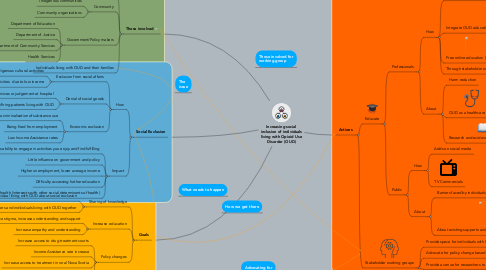
1. Those involved
1.1. Researchers
1.2. Community
1.2.1. Indigenous communities
1.2.2. Community organizations
1.3. Government/Policy makers
1.3.1. Department of Education
1.3.2. Department of Justice
1.3.3. Department of Community Services
1.3.4. Health Services
1.4. Individuals living with OUD and their families
2. Goals
2.1. Sharing of knowledge
2.1.1. Gain first hand information from individual living with OUD about social exclusion
2.1.2. Bring stakeholders, researchers and individuals living with OUD together
2.2. Increase education
2.2.1. Reduce stigma, increase understanding and support
2.2.2. Increase empathy and understanding
2.3. Policy changes
2.3.1. Increase access to drug treatment courts
2.3.2. Income Assistance rate increase
2.3.3. Increase access to treatment in rural Nova Scotia
2.3.4. Increase community supports, including access to safe injection supplies and sites
3. Social Exclusion
3.1. How
3.1.1. Exclusion from social affairs
3.1.1.1. Denied the ability to participate in some Indigenous cultural activities
3.1.1.2. Difficult to participate in cultural or social activities due to low income
3.1.2. Denial of social goods
3.1.2.1. Refusal of services or judgement at hospital
3.1.2.2. Physicians refusing to offer ORT/firing patients living with OUD
3.1.3. Economic exclusion
3.1.3.1. Difficulty finding employment due to criminalization of substance use
3.1.3.2. Being fired from employment
3.1.3.3. Low Income Assistance rates
3.2. Impact
3.2.1. Decreases ability to engage in activities you enjoy and find fulfilling
3.2.2. Little influence on government and policy
3.2.3. Higher unemployment, lower average income
3.2.4. Difficulty accessing further education
3.2.5. Decreased overall health (intersects with other social determinants of health)
4. The issue
5. Advocating for
6. Those involved for working group
7. What needs to happen
8. How we get there
9. Actions
9.1. Educate
9.1.1. Professionals
9.1.1.1. How
9.1.1.1.1. Presentations and education days
9.1.1.1.2. Integrate OUD education into University and College curriculum
9.1.1.1.3. Free online education ( http://www.bccsu.ca )
9.1.1.1.4. Through stakeholder working groups (collaborative conversations)
9.1.1.2. About
9.1.1.2.1. Harm reduction
9.1.1.2.2. OUD as a healthcare issue
9.1.1.2.3. Research and evidence based practices
9.1.2. Public
9.1.2.1. How
9.1.2.1.1. Adds on social media
9.1.2.1.2. TV Commercials
9.1.2.2. About
9.1.2.2.1. Barriers faced by individuals living with OUD
9.1.2.2.2. About existing supports and resources ( http://www.nsnaloxone.com/ )
9.2. Stakeholder working groups
9.2.1. Provide space for individuals with OUD to share their experiences
9.2.2. Advocate for policy change based on research and experience of members
9.2.3. Provide a venue for researchers to share information and receive feedback

